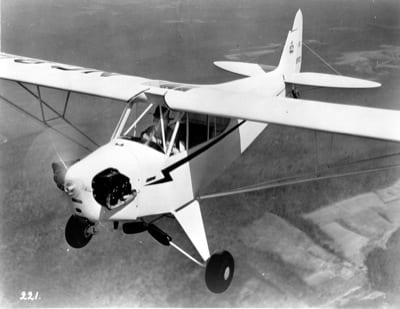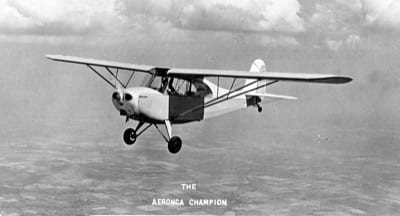On May 17, 1945, with the war in Europe ending and military production being cut back, the War Production Board announced the end of the prohibition on the production of civilian aircraft, providing such manufacturing didn’t interfere with war output.
Aviation magazines and the mainstream press jumped on the news of the post-war aviation potential. Articles such as “Lightplane Production Go-Ahead” in the May 21, 1945, issue of Aviation News, “Low-Price Plane Potentials,” in the July 1945 issue of Aero Digest, along with a survey by Esquire on the lightplane market, were some of the harbingers of the post-war boom expected for the lightplane industry.
Indeed, there was a huge boom in lightplane production, but it would be short-lived.

The predictions were for a very healthy market. ln fact, today it is hard to believe that they were taken seriously. Victor Pero, chief of the Industry War Board, estimated that 2.8 million families would have enough purchasing power in the next decade to buy their own plane, but he predicted that “only 1 million of them will hanker after private planes.”
As reported in the March, 1946, issue of Aero Digest, “A recent survey by one of the leading popular magazines turned up 300,000 urban families in the higher income brackets who listed a plane as either their first or second purchase contemplated.”
Added to this estimate was the possibility that rural families would want to own their own planes, adding another 100,000 prospective buyers. That total of 400,000 matched other estimates of the time.
That these expectations for the rural population remained high in the following year was reflected in a September, 1946, article in Aero Digest, “Flying Farmers Will Account for 60% of the Lightplanes.” The article provided coverage of the first annual convention of the National Flying Farmers Association held in Stillwater, Oklahoma.
The 250 members attending the convention were told by Art Boreman, chairman of the Civil Aeronautics Administration (CAA) non-scheduled flight committee, “Farmers and ranchmen of the United States are expected to purchase 60% of all the lightplanes produced during 1947-50. That means
that flying farmers will be a constantly growing influence in the development of our civil aviation.”
The CAA, in its report “Civil Aviation and the National Economy,” predicted that by 1955 aircraft registrations would reach 400,000, of which 320,000 would be for personal and business use.
The outlook looked good in early 1946. The March issue of Aero Digest stated “A survey of editors of 132 publications, completed recently by the Associated Business Papers organization, reveals that 21 manufacturers have a total of 53,000 orders on their books.”
The aviation magazines were full of articles on lightplanes. The Industrial Arts Index for 1945 listed 85 articles on lightplanes and in 1946 110 were listed. During this same time, issues of Flying and Skyways magazines had as many as 16 pages of full page ads for personal planes.
Trying to reach a broader audience outside the aviation journals, Piper, Beech and other companies were advertising in Business Week, Life, and Better Homes and Gardens, among others. The market looked so promising that department stores got into the act, displaying and selling aircraft in their stores. In 1946, Marshall Field in Chicago sold 40 Ercoupes in the first month of display.
The fall of 1945 saw the Type Certification of the first of the new post-war lightplanes when the Aeronca 7AC Champion received Type number 759 on Oct. 18. By the end of 1946, 18 more planes would be certified, including the Aeronca Chief, Globe Swift, Stinson Voyager, Cessna 120, and the Ercoupe.

These aircraft were well received in the various aviation magazines. From March 1945 to December 1946 lightplanes graced the covers of 46 issues of Air Facts, Flying, and Skyways.
The first pilot report on the new planes appeared in the November 1945 issue of Air Facts. This flight test was of the Stinson Voyager. The first pilot report to appear in Skyways was in February 1946 and the first for Flying was in May 1946. These were both of the Stinson Voyager.
From November 1945 until December 1946 these three magazines, which appealed to personal pilots, carried out 31 flight tests on 20 different planes. No plane besides the Voyager was covered in all three journals. Others covered in two of the three included the Aeronca Champion, Beech Bonanza, Cessna 140, Swift, Navion, and the Piper Super Cruiser.
Another indicator of the boom was the Institute for Aeronautical Sciences (IAS) National Light Aircraft Meeting held in Detroit during the summer of 1946. This two-day meeting was attended by more than 200 aeronautical engineers.
November 1946 probably was the highwater mark of the boom with the holding of the first National Aircraft Show in Cleveland. From the December 1946 issue of Aviation: “The one word ‘Big’ is the best single adjective to apply to the nation’s first postwar National Aircraft Show, held in the huge wartime bomber plant at Cleveland Airport.
First, it was the biggest show in the industry’s history from the standpoint of participation, with more than 155 exhibitors. Second, it attracted the largest audience to ever view an indoor aircraft display, the final topping 150,000 paid admissions. Third, the actual floor space — some 500,000 square feet — was the largest ever devoted to an aeronautical display.”
In truth, lightplane production was at a level never to be reached again. At the overall production peak in August and September 1946, 4,000 aircraft were being turned out a month. By itself, Aeronca was producing about 1,000 each month.
At the beginning of 1947 there were more than 400,000 licensed pilots, 189,156 with private pilot licenses. There were more than 30 personal aircraft models for the private owner to consider when buying a flying machine for business or pleasure, ranging from two- to seven-place machines. No less than 17 companies were competing for sales in this market segment.
Personal aircraft production had gone from 1,946 planes in 1945 to an unbelievable 33,254 planes. The end of 1946 saw 81,000 civil aircraft in operation. Of the close to 61,000 single engine civil aircraft registered, more than 43,000 were powered by engines of under 145 horsepower. Close to 31,000 had 65 horsepower or less.
This was truly the golden era of the lightplane. But, it was a short-lived one as the market rapidly went sour, as returning GIs and the public were struggling with economic issues, war industry layoffs, and financing college educations, while young families weren’t drawn to being plane owners. Sales in 1947 fell to around 15,515 planes, and by 1949 had plunged to 3,500.
The post-war boom was a unique event in the history of the lightplane — one never to be seen again.

Dennis, great article and chronicling of this phenom. Was in aircraft sales myself in much more recent times — with Beechcraft & Gulfstream. The vagaries never stop.
I have a media question. Your second paragraph mentions “May 21, 1945, issue of Aviation News.” I am researching an all-veterans commercial airline my Dad founded in 1945, Veterans Air Express and Veterans Air Line, based at Newark Air Depot (as they called it back then).
Dad’s list of publicity shows Aviation News giving them coverage at least 6 times between 3/1/1946 and 6/22/1946. I would love to find those articles, but so far not been able. Wondering if you can share with me how you actually found a copy of an Aviation News story – as opposed to just a bibliography reference? Would really appreciate any input.
A little late, but it occurred to me I should give you my website to more fully explain my objective.
http://www.VeteransAir.org
Yep and this was the era that predicted flying cars within thirty years. Trouble is all those predictions required that people make three times as much money while their expenses stayed the same. I refer to this as day dreaming.